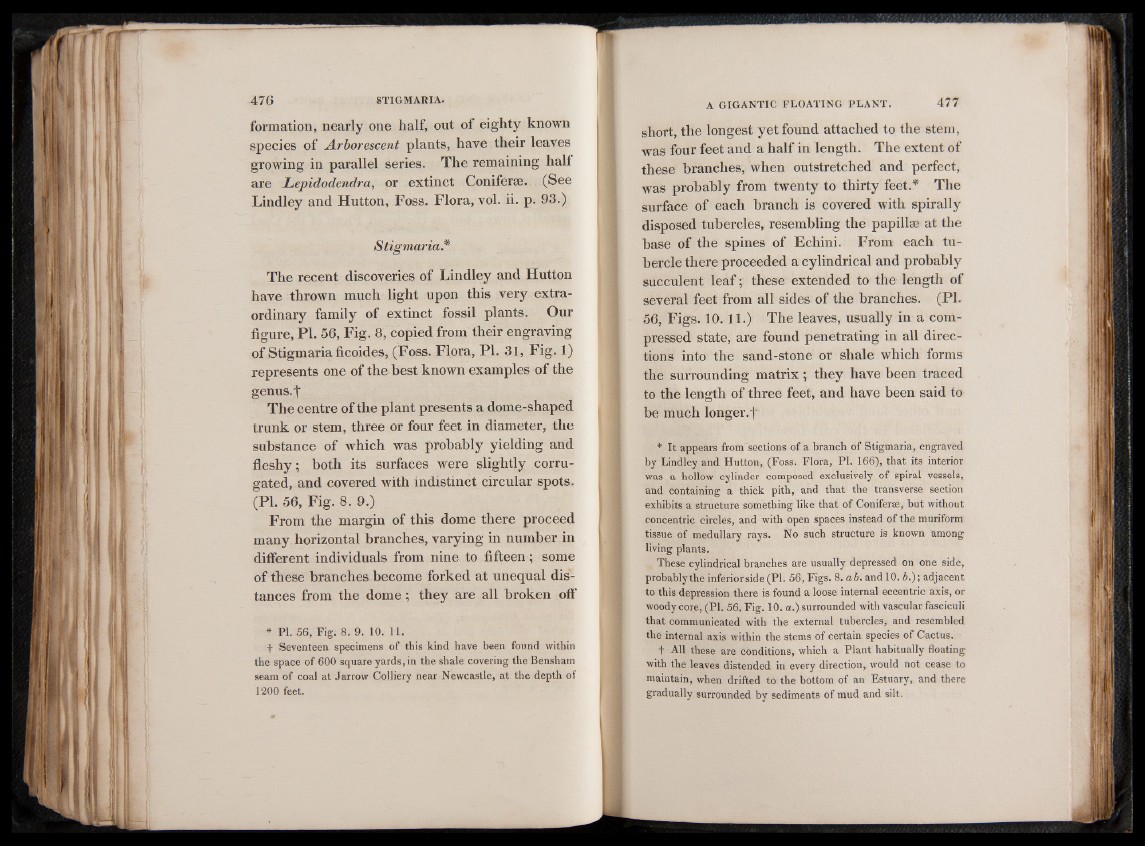
formation, nearly one half, out of eighty known
species of Arborescent plants, have their leaves
growing in parallel series. The remaining half
are Lepidodendra, or extinct Coniferse. (See
Lindley and Hutton, Foss. Flora, vol. ii. p. 93.)
Stigmaria*
The recent discoveries of Lindley and Hutton
have thrown much light upon this very extraordinary
family of extinct fossil plants. Our
figure, PI. 56, Fig. 8, copied from their engraving
of Stigmaria ficoides, (Foss. Flora, PI. 31, Fig. 1)
represents one of the best known examples of the
genus.f
The centre of the plant presents a dome-shaped
trunk or stem, three or four feet in diameter, the
substance of which was probably yielding and
fleshy; both its surfaces were slightly corrugated,
and covered with indistinct circular spots.
(PI. 56, Fig. 8. 9.)
From the margin of this dome there proceed
many horizontal branches, varying in number in
different individuals from nine to fifteen; some
of these branches become forked at unequal distances
from the dome ; they are all broken off
* PI. 56, Fig. 8. 9. 10. 11.
f Seventeen specimens of this kind have been found within
the space of 600 square yards, in the shale covering the Bensham
seam of coal at Jarrow Colliery near Newcastle, at the depth of
short, the longest yet found attached to the stem,
was four feet and a half in length. The extent of
these branches, when outstretched and perfect,
was probably from twenty to thirty feet.* The
surface of each branch is covered with spirally
disposed tubercles, resembling the papillae at the
base of the spines of Echini. From each tubercle
there proceeded a cylindrical and probably
succulent leaf; these extended to the length of
several feet from all sides of the branches. (PI.
56, Figs. 10.11.) The leaves, usually in a compressed
state, are found penetrating in all directions
into the sand-stone or shale which forms
the surrounding matrix ; they have been traced
to the length of three feet, and have been said to
be much longer, t
* It appears from sections of a branch of Stigmaria, engraved
by Lindley and Hutton, (Foss. Flora, PI. 166), that its interior
was a hollow cylinder composed exclusively of spiral vessels,
and containing a thick pith, and that the transverse section
exhibits a structure something like that of Coniferse, but without
concentric circles, and with open spaces instead of the muriform
tissue of medullary rays. No such structure is known among
living plants.
These cylindrical branches are usually depressed on one side,
probablythe inferiorside (PI. 56, Figs. 8. ab. and 10. b.) ; adjacent
to this depression there is found a loose internal eccentric axis, or
woody core, (PI. 56. Fig. 10. a.) surrounded with vascular fasciculi
that communicated with the external tubercles, and resembled
the internal axis within the stems of certain species of Cactus.
t All these are conditions, which a Plant habitually floating
with the leaves distended in every direction, would not cease to
maintain, when drifted to the bottom of an Estuary, and there
gradually surrounded by sediments of mud and silt.